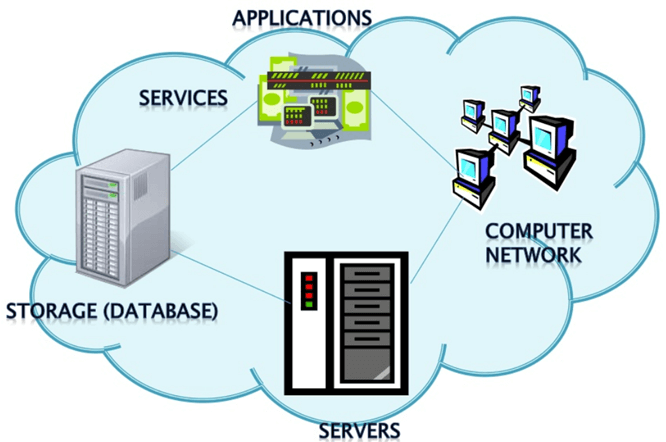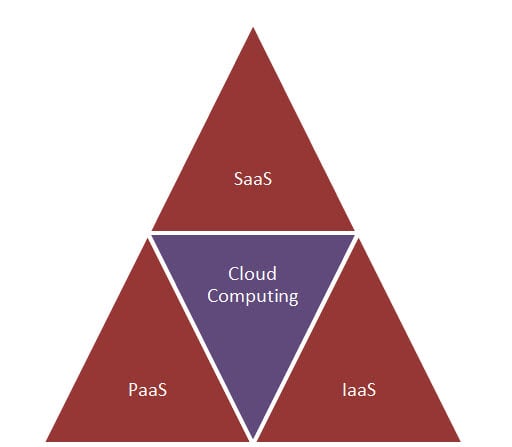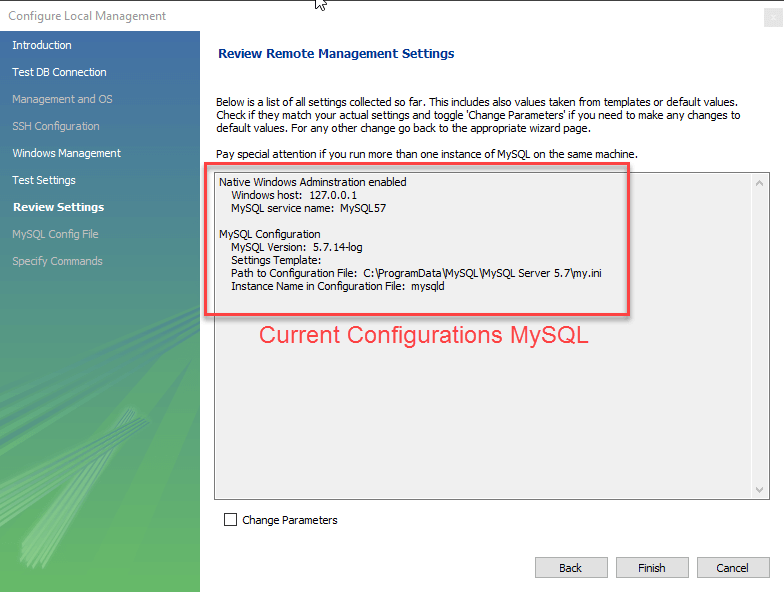What is Cloud Computing?
Cloud Computing can be defined as delivering computing power( CPU, RAM, Network Speeds, Storage OS software) a service over a network (usually on the internet) rather than physically having the computing resources at the customer location.
Example: AWS, Azure, Google Cloud
Let’s learn Cloud computing with an example -
Whenever you travel through a bus or train, you take a ticket for your destination and hold back to your seat till you reach your destination. Likewise other passengers also takes ticket and travel in the same bus with you and it hardly bothers you where they go. When your stop comes you get off the bus thanking the driver. Cloud computing is just like that bus, carrying data and information for different users and allows to use its service with minimal cost.
In this tutorial, you will learn
Why the Name Cloud?
The term “Cloud” came from a network design that was used by network engineers to represent the location of various network devices and there inter-connection. The shape of this network design was like a cloud.
Why Cloud Computing?
With increase in computer and Mobile user’s, data storage has become a priority in all fields. Large and small scale businesses today thrive on their data & they spent a huge amount of money to maintain this data. It requires a strong IT support and a storage hub. Not all businesses can afford high cost of in-house IT infrastructure and back up support services. For them Cloud Computing is a cheaper solution. Perhaps its efficiency in storing data, computation and less maintenance cost has succeeded to attract even bigger businesses as well.
Cloud computing decreases the hardware and software demand from the user’s side. The only thing that user must be able to run is the cloud computing systems interface software, which can be as simple as Web browser, and the Cloud network takes care of the rest. We all have experienced cloud computing at some instant of time, some of the popular cloud services we have used or we are still using are mail services like gmail, hotmail or yahoo etc.
While accessing e-mail service our data is stored on cloud server and not on our computer. The technology and infrastructure behind the cloud is invisible. It is less important whether cloud services are based on HTTP, XML, Ruby, PHP or other specific technologies as far as it is user friendly and functional. An individual user can connect to cloud system from his/her own devices like desktop, laptop or mobile.
Cloud computing harnesses small business effectively having limited resources, it gives small businesses access to the technologies that previously were out of their reach. Cloud computing helps small businesses to convert their maintenance cost into profit. Let’s see how?
In an in-house IT server, you have to pay a lot of attention and ensure that there are no flaws into the system so that it runs smoothly. And in case of any technical glitch you are completely responsible; it will seek a lot of attention, time and money for repair. Whereas, in cloud computing, the service provider takes the complete responsibility of the complication and the technical faults.
Benefits of Cloud Computing
The potential for cost saving is the major reason of cloud services adoption by many organizations. Cloud computing gives the freedom to use services as per the requirement and pay only for what you use. Due to cloud computing it has become possible to run IT operations as a outsourced unit without much in-house resources.
Following are the benefits of cloud computing:
- Lower IT infrastructure and computer costs for users
- Improved performance
- Fewer Maintenance issues
- Instant software updates
- Improved compatibility between Operating systems
- Backup and recovery
- Performance and Scalability
- Increased storage capacity
- Increase data safety
Types of Clouds
There are four different cloud models that you can subscribe according to business needs:
- Private Cloud: Here, computing resources are deployed for one particular organization. This method is more used for intra-business interactions. Where the computing resources can be governed, owned and operated by the same organization.
- Community Cloud: Here, computing resources are provided for a community and organizations.
- Public Cloud: This type of cloud is used usually for B2C (Business to Consumer) type interactions. Here the computing resource is owned, governed and operated by government, an academic or business organization.
- Hybrid Cloud: This type of cloud can be used for both type of interactions - B2B (Business to Business) or B2C ( Business to Consumer). This deployment method is called hybrid cloud as the computing resources are bound together by different clouds.
Cloud Computing Services
The three major Cloud Computing Offerings are
- Software as a Service (SaaS)
- Platform as a Service (PaaS)
- Infrastructure as a Service (IaaS)
Different business use some or all of these components according to their requirement.
SaaS (Software as a Service)
SaaS or software as a service is a software distribution model in which applications are hosted by a vendor or service provider and made available to customers over a network (internet). SaaS is becoming an increasingly prevalent delivery model as underlying technologies that supports Service Oriented Architecture (SOA) or Web Services. Through internet this service is available to users anywhere in the world.
Traditionaly, software application needed to be purchased upfront &then installed it onto your computer. SaaS users on the other hand, instead of purchasing the software subscribes to it, usually on monthly basisvia internet.
Anyone who needs an access to a particular piece of software can be subscribe as a user, whether it is one or two people or every thousands of employees in a corporation. SaaS is compatible with all internet enabled devices.
Many important tasks like accounting, sales, invoicing and planning all can be performed using SaaS.
PaaS (Platform as a Service)
Platform as a service, is referred as PaaS, it provides a platform and environment to allow developers to build applications and services. This service is hosted in the cloud and accessed by the users via internet.
To understand in a simple terms, let compare this with painting a picture, where you are provided with paint colors, different paint brushes and paper by your school teacher and you just have to draw a beautiful picture using those tools.
PaaS services are constantly updated & new features added. Software developers, web developers and business can benefit from PaaS. It provides platform to support application development. It includes software support and management services, storage, networking, deploying, testing, collaborating, hosting and maintaining applications.
IaaS (Infrastructure as a Service)
IaaS (Infrastructure As A Service) is one of the fundamental service model of cloud computing alongside PaaS( Platform as a Service). It provides access to computing resources in a virtualized environment “the cloud” on internet. It provides computing infrastructure like virtual server space, network connections, bandwidth, load balancers and IP addresses. The pool of hardware resource is extracted from multiple servers and networks usually distributed across numerous data centers. This provides redundancy and reliability to IaaS.
IaaS(Infrastructure as a service) is a complete package for computing. For small scale businesses who are looking for cutting cost on IT infrastructure, IaaS is one of the solutions. Annually a lot of money is spent in maintenance and buying new components like hard-drives, network connections, external storage device etc. which a business owner could have saved for other expenses by using IaaS.
What is Cloud Computing Architecture?
Let’s have a look into Cloud Computing and see what Cloud Computing is made of. Cloud computing comprises of two components front end and back end. Front end consist client part of cloud computing system. It comprise of interfaces and applications that are required to access the cloud computing platform.
While back end refers to the cloud itself, it comprises of the resources that are required for cloud computing services. It consists of virtual machines, servers, data storage, security mechanism etc. It is under providers control.
Cloud computing distributes the file system that spreads over multiple hard disks and machines. Data is never stored in one place only and in case one unit fails the other will take over automatically. The user disk space is allocated on the distributed file system, while another important component is algorithm for resource allocation. Cloud computing is a strong distributed environment and it heavily depends upon strong algorithm.
Virtualization and Cloud Computing
The main enabling technology for Cloud Computing is Virtualization. Virtualization is a partitioning of single physical server into multiple logical servers. Once the physical server is divided, each logical server behaves like a physical server and can run an operating system and applications independently. Many popular companies’s like VmWare and Microsoft provide virtualization services, where instead of using your personal PC for storage and computation, you use their virtual server. They are fast, cost-effective and less time consuming.
For software developers and testers virtualization comes very handy, as it allows developer to write code that runs in many different environments and more importantly to test that code.
Virtualization is mainly used for three main purposes 1) Network Virtualization 2) Server Virtualization 3) Storage Virtualization
Network Virtualization: It is a method of combining the available resources in a network by splitting up the available bandwidth into channels, each of which is independent from the others and each channel is independent of others and can be assigned to a specific server or device in real time.
Storage Virtualization: It is the pooling of physical storage from multiple network storage devices into what appears to be a single storage device that is managed from a central console. Storage virtualization is commonly used in storage area networks (SANs).
Server Virtualization: Server virtualization is the masking of server resources like processors, RAM, operating system etc, from server users. The intention of server virtualization is to increase the resource sharing and reduce the burden and complexity of computation from users.
Virtualization is the key to unlock the Cloud system, what makes virtualization so important for the cloud is that it decouples the software from the hardware. For example, PC’s can use virtual memory to borrow extra memory from the hard disk. Usually hard disk has a lot more space than memory. Although virtual disks are slower than real memory, if managed properly the substitution works perfectly. Likewise, there is software which can imitate an entire computer, which means 1 computer can perform the functions equals to 20 computers.
Grid Computing Vs Cloud Computing
When we switch on the fan or any electric device, we are less concern about the power supply from where it comes and how it is generated. The power supply or electricity that we receives at our home travels through a chain of network, which includes power stations, transformers, power lines and transmission stations. These components together make a ‘Power Grid’. Likewise, ‘Grid Computing’ is an infrastructure that links computing resources such as PCs, servers, workstations and storage elements and provides the mechanism required to access them.
Grid Computing is a middle ware to co-ordinate disparate IT resources across a network, allowing them to function as whole. It is more often used in scientific research and in universities for educational purpose. For example, a group of architect students working on a different project requires a specific designing tool and a software for designing purpose but only couple of them got access to this designing tool, the problem is how they can make this tool available to rest of the students. To make available for other students they will put this designing tool on campus network, now the grid will connect all these computers in campus network and allow student to use designing tool required for their project from anywhere.
Cloud computing and Grid computing is often confused, though there functions are almost similar there approach for their functionality is different. Let see how they operate-
Cloud Computing
|
Grid Computing
|
|---|
- Cloud computing works more as a service provider for utilizing computer resource
|
- Grid computing uses the available resource and interconnected computer systems to accomplish a common goal
|
- Cloud computing is a centralized model
|
- Grid computing is a decentralized model, where the computation could occur over many administrative model
|
- Cloud is a collection of computers usually owned by a single party.
-
|
- A grid is a collection of computers which is owned by a multiple parties in multiple locations and connected together so that users can share the combined power of resources
|
- Cloud offers more services all most all the services like web hosting, DB (Data Base) support and much more
|
- Grid provides limited services
|
- Cloud computing is typically provided within a single organization (eg : Amazon)
|
- Grid computing federates the resources located within different organization.
|
Utility Computing Vs Cloud Computing
In our previous conversation in “Grid Computing” we have seen how electricity is supplied to our house, also we do know that to keep electricity supply we have to pay the bill. Utility Computing is just like that, we use electricity at home as per our requirement and pay the bill accordingly likewise you will use the services for the computing and pay as per the use this is known as ‘Utility computing’. Utility computing is a good source for small scale usage, it can be done in any server environment and requires Cloud Computing.
Utility computing is the process of providing service through an on-demand, pay per use billing method. The customer or client has access to a virtually unlimited supply of computing solutions over a virtual private network or over the internet, which can be sourced and used whenever it’s required. Based on the concept of utility computing , grid computing, cloud computing and managed IT services are based.
Through utility computing small businesses with limited budget can easily use software like CRM (Customer Relationship Management) without investing heavily on infrastructure to maintain their clientele base.
Utility Computing
|
Cloud Computing
|
|---|
- Utility computing refers to the ability to charge the offered services, and charge customers for exact usage
|
- Cloud Computing also works like utility computing, you pay only for what you use but Cloud Computing might be cheaper, as such, Cloud based app can be up and running in days or weeks.
|
- Utility computing users want to be in control of the geographical location of the infrastructure
|
- In cloud computing, provider is in complete control of cloud computing services and infrastructure
|
- Utility computing is more favorable when performance and selection infrastructure is critical
|
- Cloud computing is great and easy to use when the selection infrastructure and performance is not critical
|
- Utility computing is a good choice for less resource demanding
|
- Cloud computing is a good choice for high resource demanding
|
- Utility computing refers to a business model
|
- Cloud computing refers to the underlying IT architecture
|
Security concerns for Cloud Computing
While using cloud computing, the major issue that concerns the users is about its security.
One concern is that cloud providers themselves may have access to customer’s unencrypted data- whether it’s on disk, in memory or transmitted over the network.
Some countries government may decide to search through data without necessarily notifying the data owner, depending on where the data resides, which is not appreciated and is considered as a privacy breach (Example Prism Program by USA).
To provide security for systems, networks and data cloud computing service providers have joined hands with TCG ( Trusted Computing Group) which is non-profit organization which regularly releases a set of specifications to secure hardware, create self-encrypting drives and improve network security. It protects the data from root kits and malware.
As computing has expanded to different devices like hard disk drives and mobile phones, TCG has extended the security measures to include these devices. It provides ability to create a unified data protection policy across all clouds.
Some of the trusted cloud services are Amazon, Box.net, Gmail and many others.
Privacy Concern & Cloud Computing
Privacy present a strong barrier for users to adapt into Cloud Computing systems
There are certain measures which can improve privacy in cloud computing.
- The administrative staff of the cloud computing service could theoretically monitor the data moving in memory before it is stored in disk.To keep the confidentiality of a data, administrative and legal controls should prevent this from happening.
- The other way for increasing the privacy is to keep the data encrypted at the cloud storage site, preventing unauthorized access through the internet; even cloud vendor can’t access the data either.
Reference URL:





























